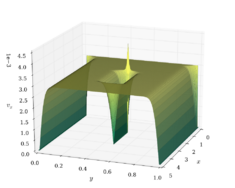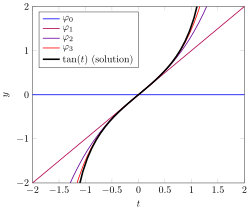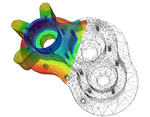Picard–Lindelöf theorem
| Differential equations |
|---|
 |
| Classification |
| Solution |
In mathematics, specifically the study of differential equations, the Picard–Lindelöf theorem gives a set of conditions under which an initial value problem has a unique solution. It is also known as Picard's existence theorem, the Cauchy–Lipschitz theorem, or the existence and uniqueness theorem.
The theorem is named after Émile Picard, Ernst Lindelöf, Rudolf Lipschitz and Augustin-Louis Cauchy.
Theorem
Let [math]\displaystyle{ D \subseteq \R \times \R^n }[/math] be a closed rectangle with [math]\displaystyle{ (t_0, y_0) \in \operatorname{int} D }[/math], the interior of [math]\displaystyle{ D }[/math]. Let [math]\displaystyle{ f: D \to \R^n }[/math] be a function that is continuous in [math]\displaystyle{ t }[/math] and Lipschitz continuous in [math]\displaystyle{ y }[/math]. Then, there exists some ε > 0 such that the initial value problem
[math]\displaystyle{ y'(t)=f(t,y(t)),\qquad y(t_0)=y_0. }[/math]
has a unique solution [math]\displaystyle{ y(t) }[/math] on the interval [math]\displaystyle{ [t_0-\varepsilon, t_0+\varepsilon] }[/math].[1][2]
Proof sketch
The proof relies on transforming the differential equation, and applying the Banach fixed-point theorem. By integrating both sides, any function satisfying the differential equation must also satisfy the integral equation
- [math]\displaystyle{ y(t) - y(t_0) = \int_{t_0}^t f(s,y(s)) \, ds. }[/math]
A simple proof of existence of the solution is obtained by successive approximations. In this context, the method is known as Picard iteration.
Set
- [math]\displaystyle{ \varphi_0(t)=y_0 }[/math]
and
- [math]\displaystyle{ \varphi_{k+1}(t)=y_0+\int_{t_0}^t f(s,\varphi_k(s))\,ds. }[/math]
It can then be shown, by using the Banach fixed-point theorem, that the sequence of "Picard iterates" φk is convergent and that the limit is a solution to the problem. An application of Grönwall's lemma to |φ(t) − ψ(t)|, where φ and ψ are two solutions, shows that φ(t) = ψ(t), thus proving the global uniqueness (the local uniqueness is a consequence of the uniqueness of the Banach fixed point).
See Newton's method of successive approximation for instruction.
Example of Picard iteration
Let [math]\displaystyle{ y(t)=\tan(t), }[/math] the solution to the equation [math]\displaystyle{ y'(t)=1+y(t)^2 }[/math] with initial condition [math]\displaystyle{ y(t_0)=y_0=0,t_0=0. }[/math] Starting with [math]\displaystyle{ \varphi_0(t)=0, }[/math] we iterate
- [math]\displaystyle{ \varphi_{k+1}(t)=\int_0^t (1+(\varphi_k(s))^2)\,ds }[/math]
so that [math]\displaystyle{ \varphi_n(t) \to y(t) }[/math]:
- [math]\displaystyle{ \varphi_1(t)=\int_0^t (1+0^2)\,ds = t }[/math]
- [math]\displaystyle{ \varphi_2(t)=\int_0^t (1+s^2)\,ds = t + \frac{t^3}{3} }[/math]
- [math]\displaystyle{ \varphi_3(t)=\int_0^t \left(1+\left(s + \frac{s^3}{3}\right)^2\right)\,ds = t + \frac{t^3}{3} + \frac{2t^5}{15} + \frac{t^7}{63} }[/math]
and so on. Evidently, the functions are computing the Taylor series expansion of our known solution [math]\displaystyle{ y=\tan(t). }[/math] Since [math]\displaystyle{ \tan }[/math] has poles at [math]\displaystyle{ \pm\tfrac{\pi}{2}, }[/math] this converges toward a local solution only for [math]\displaystyle{ |t|\lt \tfrac{\pi}{ 2}, }[/math] not on all of [math]\displaystyle{ \R }[/math].
Example of non-uniqueness
To understand uniqueness of solutions, consider the following examples.[3] A differential equation can possess a stationary point. For example, for the equation dy/dt = ay ([math]\displaystyle{ a\lt 0 }[/math]), the stationary solution is y(t) = 0, which is obtained for the initial condition y(0) = 0. Beginning with another initial condition y(0) = y0 ≠ 0, the solution y(t) tends toward the stationary point, but reaches it only at the limit of infinite time, so the uniqueness of solutions (over all finite times) is guaranteed.
However, for an equation in which the stationary solution is reached after a finite time, the uniqueness fails. This happens for example for the equation dy/dt = ay 2/3, which has at least two solutions corresponding to the initial condition y(0) = 0 such as: y(t) = 0 or
- [math]\displaystyle{ y(t)=\begin{cases} \left (\tfrac{at}{3} \right )^{3} & t\lt 0\\ \ \ \ \ 0 & t \ge 0, \end{cases} }[/math]
so the previous state of the system is not uniquely determined by its state after t = 0. The uniqueness theorem does not apply because the function f (y) = y 2/3 has an infinite slope at y = 0 and therefore is not Lipschitz continuous, violating the hypothesis of the theorem.
Detailed proof
Let
- [math]\displaystyle{ C_{a,b}=\overline{I_a(t_0)}\times\overline{B_b(y_0)} }[/math]
where:
- [math]\displaystyle{ \begin{align} \overline{I_a(t_0)}&=[t_0-a,t_0+a] \\ \overline{B_b(y_0)}&=[y_0-b,y_0+b]. \end{align} }[/math]
This is the compact cylinder where f is defined. Let
- [math]\displaystyle{ M = \sup_{C_{a,b}}\|f\|, }[/math]
this is, the supremum of (the absolute values of) the slopes of the function. Finally, let L be the Lipschitz constant of f with respect to the second variable.
We will proceed to apply the Banach fixed-point theorem using the metric on [math]\displaystyle{ \mathcal{C}(I_{a}(t_0),B_b(y_0)) }[/math] induced by the uniform norm
- [math]\displaystyle{ \| \varphi \|_\infty = \sup_{t \in I_a} | \varphi(t)|. }[/math]
We define an operator between two function spaces of continuous functions, Picard's operator, as follows:
- [math]\displaystyle{ \Gamma:\mathcal{C}(I_{a}(t_0),B_b(y_0)) \longrightarrow \mathcal{C}(I_{a}(t_0),B_b(y_0)) }[/math]
defined by:
- [math]\displaystyle{ \Gamma \varphi(t) = y_0 + \int_{t_0}^{t} f(s,\varphi(s)) \, ds. }[/math]
We must show that this operator maps a complete non-empty metric space X into itself and also is a contraction mapping.
We first show that, given certain restrictions on [math]\displaystyle{ a }[/math], [math]\displaystyle{ \Gamma }[/math] takes [math]\displaystyle{ \overline{B_b(y_0)} }[/math] into itself in the space of continuous functions with the uniform norm. Here, [math]\displaystyle{ \overline{B_b(y_0)} }[/math] is a closed ball in the space of continuous (and bounded) functions "centered" at the constant function [math]\displaystyle{ y_0 }[/math]. Hence we need to show that
- [math]\displaystyle{ \| \varphi -y_0 \|_\infty \le b }[/math]
implies
- [math]\displaystyle{ \left\| \Gamma\varphi(t)-y_0 \right\| = \left\|\int_{t_0}^t f(s,\varphi(s))\, ds \right\| \leq \int_{t_0}^{t'} \left\|f(s,\varphi(s))\right\| ds \leq \int_{t_0}^{t'} M\, ds = M \left|t'-t_0 \right| \leq M a \leq b }[/math]
where [math]\displaystyle{ t' }[/math] is some number in [math]\displaystyle{ [t_0-a, t_0 +a] }[/math] where the maximum is achieved. The last inequality in the chain is true if we impose the requirement [math]\displaystyle{ a \lt \frac{b}{M} }[/math].
Now let's prove that this operator is a contraction mapping.
Given two functions [math]\displaystyle{ \varphi_1,\varphi_2\in\mathcal{C}(I_{a}(t_0),B_b(y_0)) }[/math], in order to apply the Banach fixed-point theorem we require
- [math]\displaystyle{ \left \| \Gamma \varphi_1 - \Gamma \varphi_2 \right\|_\infty \le q \left\| \varphi_1 - \varphi_2 \right\|_\infty, }[/math]
for some [math]\displaystyle{ 0 \leq q \lt 1 }[/math]. So let [math]\displaystyle{ t }[/math] be such that
- [math]\displaystyle{ \| \Gamma \varphi_1 - \Gamma \varphi_2 \|_\infty = \left\| \left(\Gamma\varphi_1 - \Gamma\varphi_2 \right)(t) \right\|. }[/math]
Then using the definition of [math]\displaystyle{ \Gamma }[/math],
- [math]\displaystyle{ \begin{align} \left\|\left(\Gamma\varphi_1 - \Gamma\varphi_2 \right)(t) \right\| &= \left\|\int_{t_0}^t \left( f(s,\varphi_1(s))-f(s,\varphi_2(s)) \right)ds \right\|\\ &\leq \int_{t_0}^t \left\|f \left(s,\varphi_1(s)\right)-f\left(s,\varphi_2(s) \right) \right\| ds \\ &\leq L \int_{t_0}^t \left\|\varphi_1(s)-\varphi_2(s) \right\|ds && \text{since } f \text{ is Lipschitz-continuous} \\ &\leq L \int_{t_0}^t \left\|\varphi_1-\varphi_2 \right\|_\infty \,ds \\ &\leq La \left\|\varphi_1-\varphi_2 \right\|_\infty \end{align} }[/math]
This is a contraction if [math]\displaystyle{ a \lt \tfrac{1}{L}. }[/math]
We have established that the Picard's operator is a contraction on the Banach spaces with the metric induced by the uniform norm. This allows us to apply the Banach fixed-point theorem to conclude that the operator has a unique fixed point. In particular, there is a unique function
- [math]\displaystyle{ \varphi\in \mathcal{C}(I_a (t_0),B_b(y_0)) }[/math]
such that Γφ = φ. This function is the unique solution of the initial value problem, valid on the interval Ia where a satisfies the condition
- [math]\displaystyle{ a \lt \min \left \{ \tfrac{b}{M}, \tfrac{1}{L} \right \}. }[/math]
Optimization of the solution's interval
We wish to remove the dependence of the interval Ia on L. To this end, there is a corollary of the Banach fixed-point theorem: if an operator Tn is a contraction for some n in N, then T has a unique fixed point. Before applying this theorem to the Picard operator, recall the following:
Lemma — [math]\displaystyle{ \left\| \Gamma^m \varphi_1(t) - \Gamma^m\varphi_2(t) \right\| \leq \frac{L^m|t-t_0|^m}{m!}\left\|\varphi_1-\varphi_2\right\| }[/math] for all [math]\displaystyle{ t \in [t_0 - \alpha, t_0 + \alpha] }[/math]
Proof. Induction on m. For the base of the induction (m = 1) we have already seen this, so suppose the inequality holds for m − 1, then we have: [math]\displaystyle{ \begin{align} \left \| \Gamma^m \varphi_1(t) - \Gamma^m\varphi_2(t) \right \| &= \left \|\Gamma\Gamma^{m-1} \varphi_1(t) - \Gamma\Gamma^{m-1}\varphi_2(t) \right \| \\ &\leq \left| \int_{t_0}^t \left \| f \left (s,\Gamma^{m-1}\varphi_1(s) \right )-f \left (s,\Gamma^{m-1}\varphi_2(s) \right )\right \| ds \right| \\ &\leq L \left| \int_{t_0}^t \left \|\Gamma^{m-1}\varphi_1(s)-\Gamma^{m-1}\varphi_2(s)\right \| ds\right| \\ &\leq L \left| \int_{t_0}^t \frac{L^{m-1}|s-t_0|^{m-1}}{(m-1)!} \left \| \varphi_1-\varphi_2\right \| ds\right| \\ &\leq \frac{L^m |t-t_0|^m }{m!} \left \|\varphi_1 - \varphi_2 \right \|. \end{align} }[/math]
By taking a supremum over [math]\displaystyle{ t \in [t_0 - \alpha, t_0 + \alpha] }[/math] we see that [math]\displaystyle{ \left \| \Gamma^m \varphi_1 - \Gamma^m\varphi_2 \right \| \leq \frac{L^m\alpha^m}{m!}\left \|\varphi_1-\varphi_2\right \| }[/math].
This inequality assures that for some large m, [math]\displaystyle{ \frac{L^m\alpha^m}{m!}\lt 1, }[/math] and hence Γm will be a contraction. So by the previous corollary Γ will have a unique fixed point. Finally, we have been able to optimize the interval of the solution by taking α = min{a, b/M}.
In the end, this result shows the interval of definition of the solution does not depend on the Lipschitz constant of the field, but only on the interval of definition of the field and its maximum absolute value.
Other existence theorems
The Picard–Lindelöf theorem shows that the solution exists and that it is unique. The Peano existence theorem shows only existence, not uniqueness, but it assumes only that f is continuous in y, instead of Lipschitz continuous. For example, the right-hand side of the equation dy/dt = y 1/3 with initial condition y(0) = 0 is continuous but not Lipschitz continuous. Indeed, rather than being unique, this equation has at least three solutions:[4]
- [math]\displaystyle{ y(t) = 0, \qquad y(t) = \pm\left (\tfrac23 t\right)^{\frac{3}{2}} }[/math].
Even more general is Carathéodory's existence theorem, which proves existence (in a more general sense) under weaker conditions on f . Although these conditions are only sufficient, there also exist necessary and sufficient conditions for the solution of an initial value problem to be unique, such as Okamura's theorem.[5]
See also
- Frobenius theorem (differential topology)
- Integrability conditions for differential systems
- Newton's method
- Euler method
- Trapezoidal rule
Notes
- ↑ (Coddington Levinson), Theorem I.3.1
- ↑ Murray, Francis; Miller, Kenneth. Existence Theorems for Ordinary Differential Equations. pp. 50.
- ↑ Arnold, V. I. (1978). Ordinary Differential Equations. The MIT Press. ISBN 0-262-51018-9.
- ↑ (Coddington Levinson), p. 7
- ↑ Agarwal, Ravi P.; Lakshmikantham, V. (1993). Uniqueness and Nonuniqueness Criteria for Ordinary Differential Equations. World Scientific. p. 159. ISBN 981-02-1357-3. https://books.google.com/books?id=q4OkW4H8BCUC&pg=PA159.
References
- Coddington, Earl A.; Levinson, Norman (1955). Theory of Ordinary Differential Equations. McGraw-Hill. ISBN 9780070992566.
- Lindelöf, E. (1894). "Sur l'application de la méthode des approximations successives aux équations différentielles ordinaires du premier ordre". Comptes rendus hebdomadaires des séances de l'Académie des sciences 118: 454–7. http://gallica.bnf.fr/ark:/12148/bpt6k3074r/f454.table. (In that article Lindelöf discusses a generalization of an earlier approach by Picard.)
- Teschl, Gerald (2012). Ordinary Differential Equations and Dynamical Systems. Graduate Studies in Mathematics. Providence, Rhode Island: American Mathematical Society. p. 38. ISBN 978-0-8218-8328-0. https://www.mat.univie.ac.at/~gerald/ftp/book-ode/.
External links
- "Cauchy-Lipschitz theorem". Encyclopedia of Mathematics. https://www.encyclopediaofmath.org/index.php/Cauchy-Lipschitz_theorem.
- Fixed Points and the Picard Algorithm, recovered from http://www.krellinst.org/UCES/archive/classes/CNA/dir2.6/uces2.6.html.
- Grant, Christopher (1999). "Lecture 4: Picard-Lindelöf Theorem". Math 634: Theory of Ordinary Differential Equations. Department of Mathematics, Brigham Young University. http://www.math.byu.edu/~grant/courses/m634/f99/lec4.pdf.
 |



